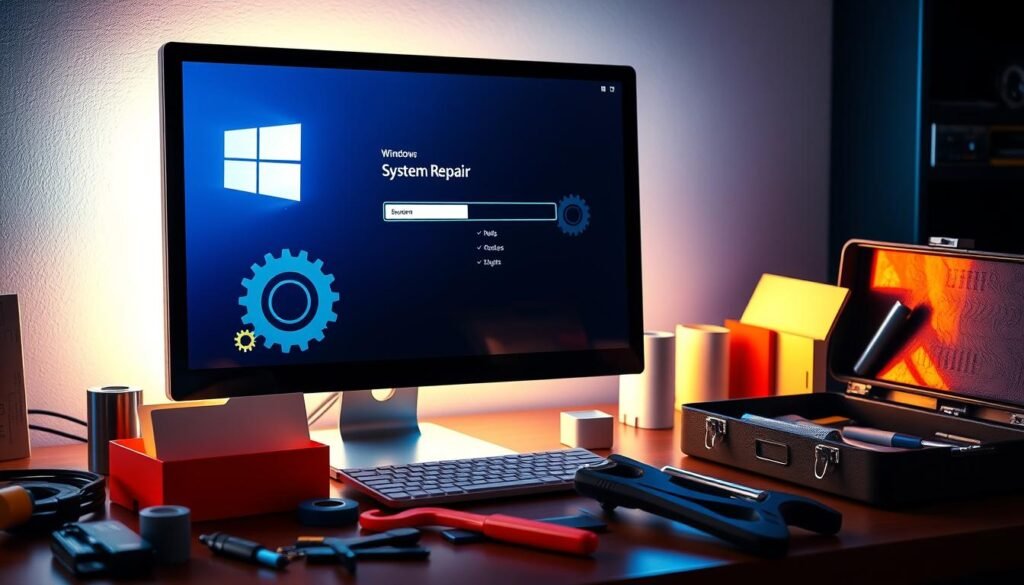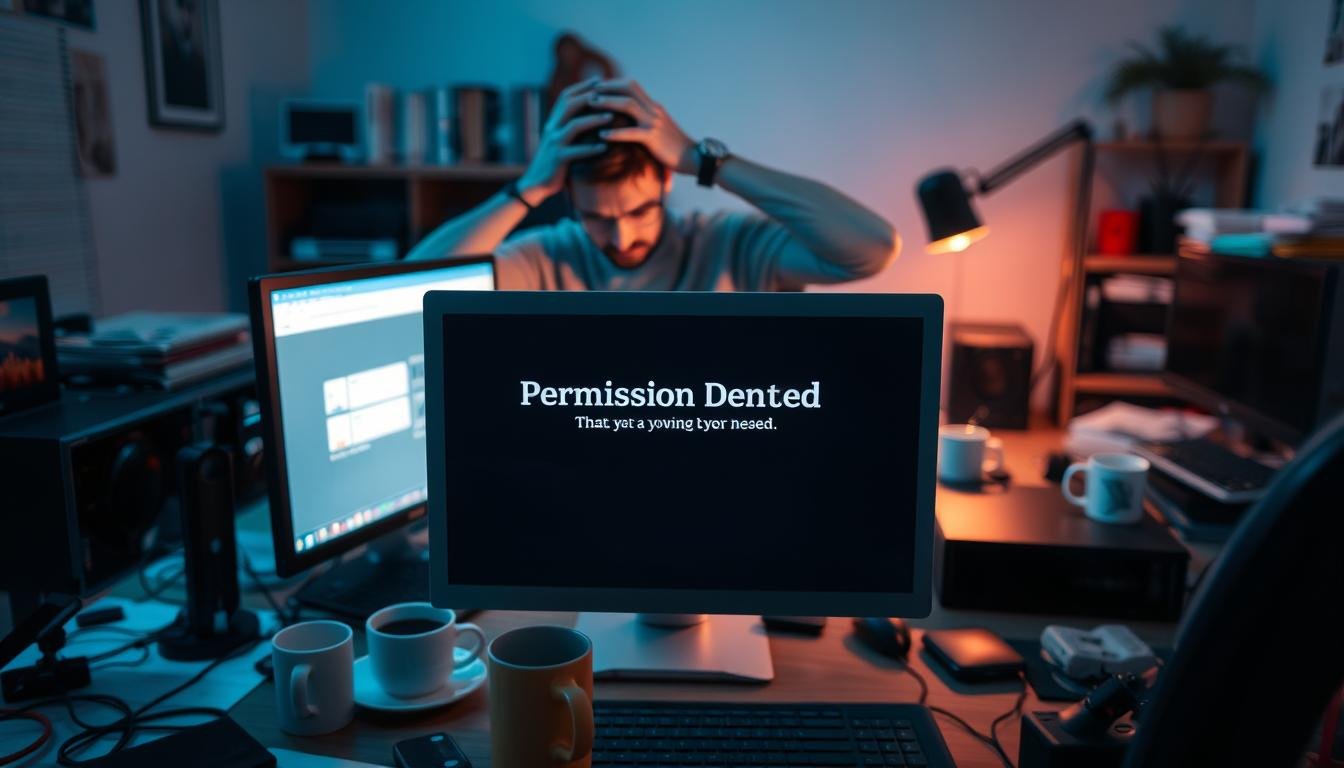Running into the “Do Not Have Permission” error on Windows can block you from accessing important files, making your work very hard. This issue is especially tough after you’ve connected devices, like a Moto Z2 Play to a Windows 10 Pro desktop.
Don’t worry! In this guide on how to fix Windows error do not have permission, I’ll show you how to resolve this problem. We’ll explore changing Windows permissions and adjusting security settings to help you regain access to your files and ease your frustration.
Key Takeaways
- Understand common causes of the “Do Not Have Permission” error.
- Learn how to adjust Windows permissions effectively.
- Resolve access denied issues with practical solutions.
- Utilize tools like AOMEI Partition Assistant for drive management.
- Modify User Account Control settings for smoother access.
Table of Contents
Understanding the “Do Not Have Permission” Error
The “Do Not Have Permission” error is really frustrating. It stops me from getting to important files or settings. This problem usually comes from not having enough access rights or Windows settings being wrong.
This error pops up in many situations. For example, when trying to open a file, start a service, or access a network share. You might see messages like “Folder Access Denied. You need permission to perform this action” or “Location is not available. E: is not accessible. Access is denied.”
Many things can cause this problem. User Account Control (UAC) rules, file permissions, and group policy settings can all block you. Also, damaged user profiles and file system problems can make it hard to access things. Knowing what causes these issues helps fix them fast.
To solve the access denied problem, you can change file or folder permissions, take ownership, or deal with encrypted files. Remember, stopping file damage is as important as fixing these errors. Saving files right, removing USB devices safely, and shutting down your computer correctly can make your experience better.
| Error Message | Possible Causes | Resolution Methods |
|---|---|---|
| “Folder Access Denied” | Permission issues, UAC restrictions | Change permissions, take ownership |
| “Location is not available. E: is not accessible.” | File system corruption, access rights | Recover data, format disk if necessary |
| Access to network share denied | Network settings, SMBv1 deprecation | Reset TCP/IP stack, configure sharing options |
| Service start failure | Service permissions | Adjust service settings, ensure proper user rights |
| Corrupted user profile message | User profile corruption | Create new local user account, restore from backup |
By knowing about these Windows errors, I can stop and fix the “Do Not Have Permission” error. This makes my computer use much better.
Common Causes of the Access Denied Error
Seeing the “Access Denied” error on Windows can be really frustrating. This problem often comes from a few common reasons. It affects both new and experienced users.
- Changes in Group Policy settings can block access, causing permission issues.
- Insufficient user permissions often leads to access problems, even for those with admin rights.
- User Account Control (UAC) settings might stop certain actions. This is especially true when elevated tokens are removed from non-elevated sessions.
- Expired or invalid cookies can also cause access restrictions. This is for users who have deleted or corrupted cookies.
- IP address or domain name issues may limit access based on where you are. This causes problems for many users trying to view specific content.
- Interference from antivirus or firewall software often blocks access to legitimate pages. This can result in an access denied error.
- Outdated website URLs may cause issues when users try to access pages using old links.
- VPN-related problems can further restrict user access. This makes browsing more complicated.
Knowing these causes can help users figure out what changes they need in their Windows security settings. This can help solve the problem.
How to Fix Windows Error Do Not Have Permission
To fix the “Do Not Have Permission” error, start with two steps. These steps can help you regain access and keep your Windows running smoothly. First, use the Windows Update Troubleshooter. Then, check the file system permissions.
Run the Windows Update Troubleshooter
Starting with the Windows Update Troubleshooter is a good idea. It finds and fixes update problems that might block your system. Old software can cause permission issues. This tool can stop many problems and keep your system safe.
Check File System Permissions
Next, check the file system permissions carefully. Look at the access rights for folders and files. Permissions can change, especially after system updates. For example, moving from Windows 7 to Windows 10 can cause permission problems.
To fix this, go to the folder properties. Make sure the permissions let users access what they need. If not, change the settings to give the right access.
| Action | Description |
|---|---|
| Run Windows Update Troubleshooter | Identifies and resolves issues related to system updates and patches that can cause permission issues. |
| Check File System Permissions | Reviews and adjusts permissions for folders to ensure users have the necessary access rights. |
| Change Folder Ownership | Modifies the ownership settings on folders to give the required user account control over the folder. |
| Stop Previous Ownership Changes | Completes or cancels any previous changes to ownership that might have caused access issues. |
| Grant Full Control | Adjusts security settings to grant full access to specific user accounts for smoother file operations. |
Checking User Account Control (UAC) Settings
User Account Control (UAC) settings in Windows are key for user permissions. If I face permission problems, it’s often because UAC is too high. This can block actions, even for admins. To start, I check UAC in the Control Panel. I go to System and Security, then Change User Account Control settings.
If UAC is too strict, I think about changing it. This lets me do admin tasks without issues. Knowing how UAC works is vital. It stops unauthorized programs from getting too much power.
For Windows 8 or 8.1 users, managing UAC is crucial. People often share tips online to fix “Do Not Have Permission” errors. Understanding UAC helps with admin tasks and keeps your system safe. This knowledge makes troubleshooting easier and improves your experience.
Setting Folder Permissions Correctly
Setting the right folder permissions is key to managing your files well. It stops unwanted access and lets users do their jobs. To set permissions in Windows, I first open the folder’s properties.
Assigning Permissions to Users
In the Security tab of the folder properties, I can give or change permissions for users and groups. This lets me decide who can read, write, or change files. It’s easy and lets me control who can access what.
- Right-click the folder and select Properties.
- Go to the Security tab.
- Click Edit to change permissions.
- Select a user or group and then assign the required permissions.
Using Advanced Security Settings
For complex needs, I use Advanced Security Settings. It gives a detailed look at access control lists (ACLs). It lets me control who can do what with fine detail. The steps are:
- Clicking the Advanced button in the Security tab.
- Viewing existing permissions and their inheritance settings.
- Adding or removing users along with customizing their access level.
Good folder permission management makes my work flow better and keeps my data safe.
Taking Ownership of the Folder or File
If I run into permission problems with a folder or file, taking ownership usually fixes it. To do this on Windows, I right-click the item and choose Properties. Then, I go to the Security tab and the Advanced Security Settings. This lets me change who owns the file, giving me back control.
I need to have admin rights to do this. This is because I need the right access to change who owns a file. There are many options, like Full Control or just Read. But, I shouldn’t change who owns system folders like Windows or Program Files. Doing so could make my system less safe.
Users often see errors like “destination folder access denied” or “you have been denied permission to access this folder.” Changing permissions usually fixes these problems. If I see “unable to display current owner,” it might be because of read-only settings or not enough permissions.
To fix issues, I try different things. I might turn off User Account Control (UAC) or boot in Safe Mode. I also check if any programs are using the files I need. If needed, I use command-line tools. The command “takeown /f C:PathtoFolder /r” from an admin prompt helps a lot.
Using Command Prompt to Fix Permission Issues
When I face permission problems in Windows, the command prompt is a great tool. The SFC /scannow command and the ICACLS command are especially useful. They help me find and fix issues quickly, which is faster than other methods.
Running SFC /scannow
The SFC /scannow command checks system files for damage. It fixes problems with program files, which can solve permission issues. To use it, I open the command prompt as an admin and type:
SFC /scannowThe scan takes some time but is thorough. After it’s done, any problems found will be fixed if possible.
Using ICACLS Command
The ICACLS command helps me manage file permissions well. It’s great for changing or checking permissions on files or folders fast. Here are some common uses:
| Command | Description |
|---|---|
ICACLS filename | Shows the current permissions for the file. |
ICACLS filename /grant username:F | Gives full access to the user. |
ICACLS filename /remove username | Takes away the user’s permissions. |
Using these commands can really help fix permission problems. With the right user settings and running as an admin, issues like “Access Denied” can be fixed well.
Repairing Windows System Files

Fixing Windows system files can make your computer run better. It helps solve problems like access denied messages. I use system file repair when I see these errors.
Once, I tried to repair files and 44 didn’t work. But 13 did. This shows how key it is to keep system files working right. Many access denied messages showed I needed to fix things fast.
Looking deeper, I found most problems came from not enough permissions. This was especially true for people using external hard drives. Wrong permission settings were the main cause.
To fix these issues, I give users full control. This works pretty well. Also, taking ownership of folders on external drives helps a lot with managing files.
Resetting apps like Photos can help a bit. But disabling User Account Control (UAC) works differently for everyone. Tools like the Program Compatibility Troubleshooter can also help with program issues.
By doing these repairs, your computer becomes more stable. It also helps solve common permission problems that users often face.
Disabling Group Policy Restrictions Temporarily
When I face the “Do Not Have Permission” error, I know Windows policy restrictions are often the cause. Disabling these policies temporarily helps me find the problem. But, I must be careful not to mess up the system’s security and how it works.
To disable group policy, I use the Group Policy Editor. Here’s how to start:
- Press Windows + R to open the Run dialog.
- Type gpedit.msc and hit Enter.
- Look through User Configuration or Computer Configuration for the policy causing trouble.
- Right-click on the policy and choose Disabled or Not Configured.
After changing settings, I run gpupdate /force in Command Prompt. This applies the new settings. If problems still exist, checking event logs like Gpsvc.log helps. It can show error codes like 5 for “Access is denied” or 49 for “Invalid credentials”. These details help find out why group policy isn’t working.
Finally, making sure the network connects well to domain controllers is key. This step is often missed but is very important for group policy to work right.
| Error Code | Description | Resolution Steps |
|---|---|---|
| 5 | Access is denied | Review folder permissions, check user permissions |
| 49 | Invalid credentials | Verify user credentials, reset passwords |
| 1129 | Group Policy fails due to network issues | Check LAN connectivity, test connection to domain controller |
| 1002 | Group Policy processing failed | Restart computer, check resource availability |
| 1006 | Authentication failure to Active Directory | Ensure correct domain settings, reauthenticate |
Creating a New Administrator Account
When I face permission problems in Windows, making a new admin account helps. It fixes many access issues. A new account usually has default permissions, fixing problems from old accounts.
Here’s how I do it:
- Open the Settings app.
- Navigate to Accounts and select Family & other users.
- Click on Add someone else to this PC.
- Follow the prompts to create an account, making sure to select the option that grants administrative rights.
This way, I get the right access for managing the system and files. If problems continue, enabling the built-in Administrator account gives full control. This account is disabled by default for security but can be turned on when needed.
Booting into Safe Mode can also help. It reduces background processes that might block account changes. If I think antivirus software is the problem, turning it off temporarily usually solves the issue.
Creating a new admin account needs admin access. It’s a good way to fix account corruption and find user-specific problems.
Checking for USB Device Permissions
Users often face “USB access denied” errors when trying to access USB drive files. These errors can appear as “access denied for USB drive” or “flash drive not accessible, access denied.” Most of the time, these issues come from Windows security and permission settings, not from the USB itself.
When dealing with these access denials, I look at software adjustments. Things like User Account Control (UAC) settings, ownership conflicts, and file permissions can cause problems. It’s important to check these elements. I suggest checking USB access in Device Manager to see if it’s recognized. You can also use File Explorer to look at the security settings on the drive.
| Step | Action |
|---|---|
| 1 | Open Device Manager. |
| 2 | Locate your USB device and right-click it. |
| 3 | Select “Properties,” then navigate to the “Security” tab (if available). |
| 4 | Review the permissions assigned to your user account. |
| 5 | If there are restrictions, adjust them and try accessing the drive again. |
By making sure USB device permissions are correct, I can usually fix these frustrating access issues. Checking and adjusting these settings helps me access my important files easily, without any problems.
Conclusion
Fixing access denied errors like the “Do Not Have Permission” message on Windows is key. You need to check folder permissions and adjust User Account Control settings. Also, verify system files to regain access.
Knowing how to adjust folder permissions and take ownership is vital. It helps keep your system running well and safe. Running tools like DISM and SFC can also fix file system problems.
This article is a guide to help you fix permission errors and regain access. Whether you use data recovery software or change system settings, you’re not alone. By using the strategies here, you can overcome these issues and improve your Windows experience.






0 Comments